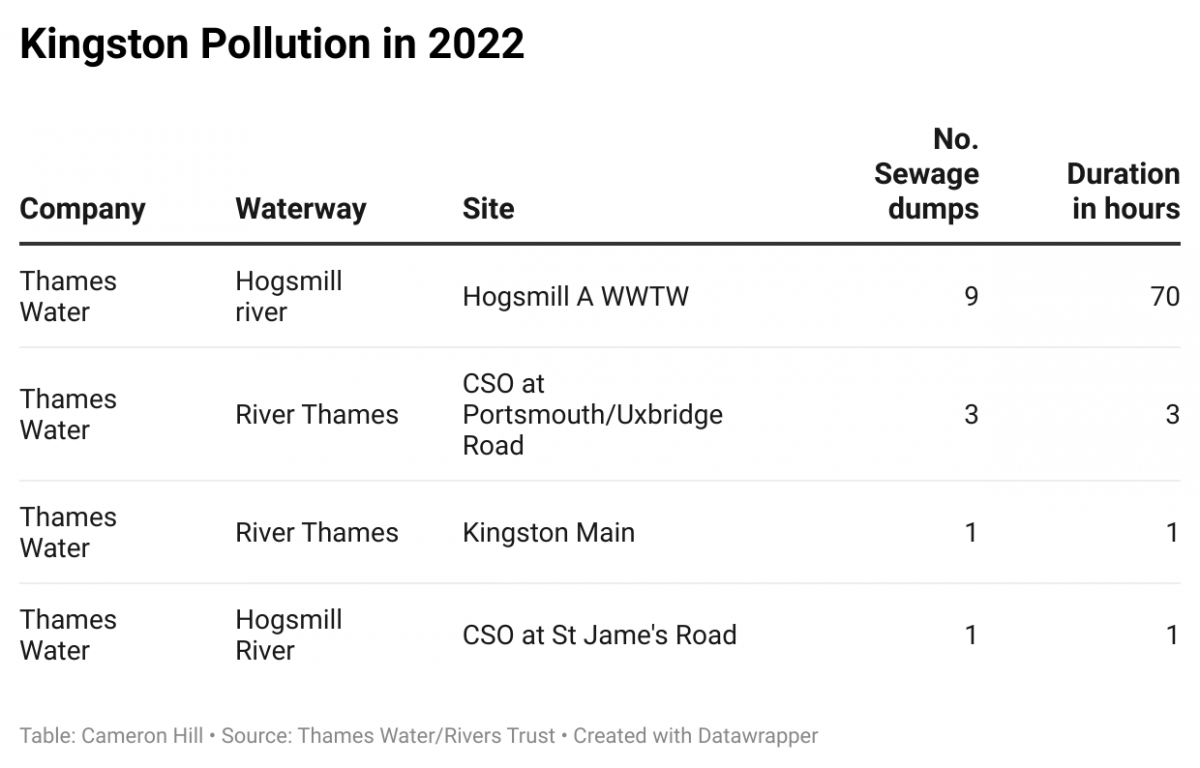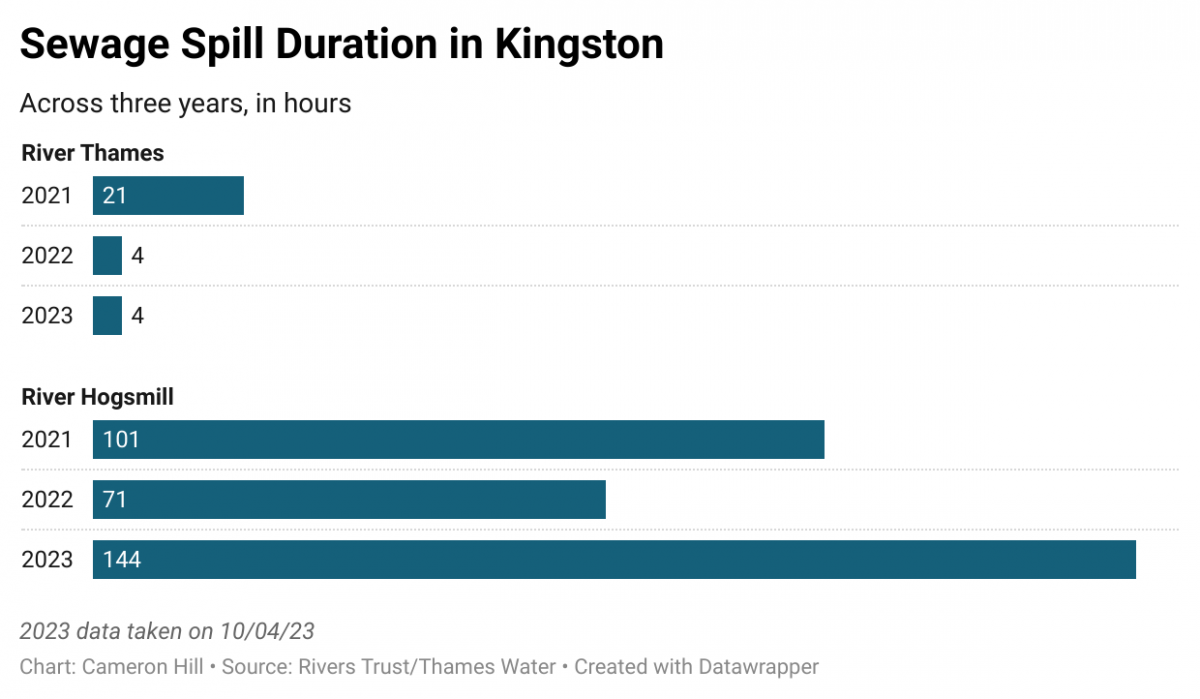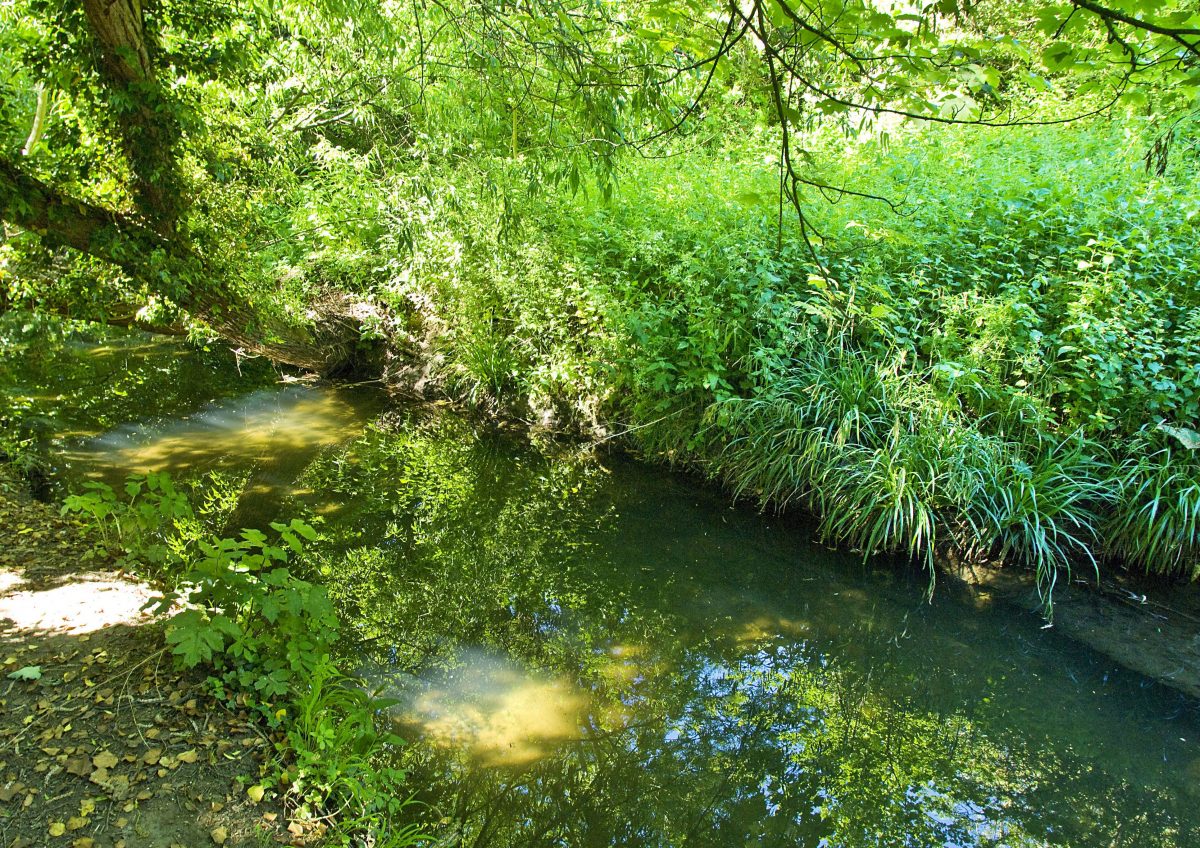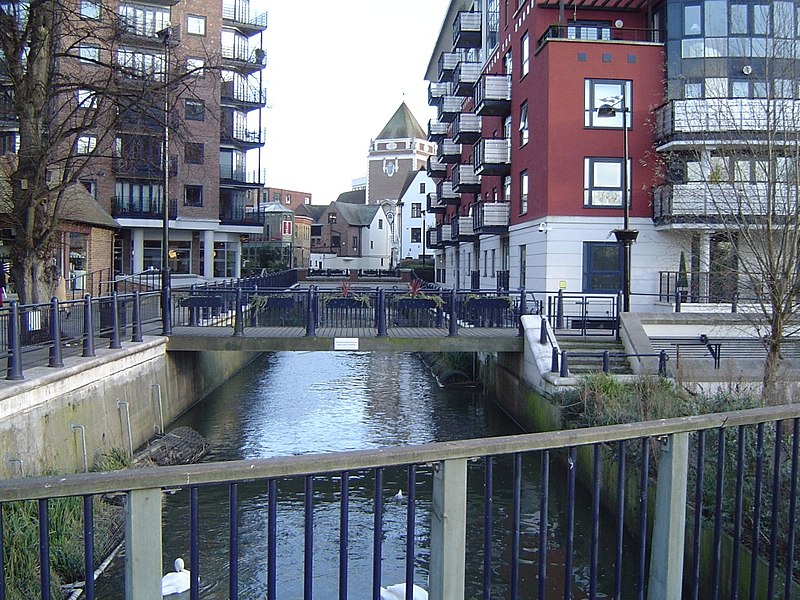New data from The Rivers Trust has shown that Thames Water continued to dump raw sewage into Kingston’s rivers, totalling 75 hours of waste released.
The Rivers Trust, which monitor sewage spills into the nation’s rivers, released its updated information for 2022 on April 6.
It uses a catchment based approach system to monitor storm overflows across the UK, using data made available by water companies themselves and citizen reports of sewage spills, which are monitored by the trust.
The Rivers Trust reported a total of 14 sewage spills into Kingston’s Rivers, the Thames and Hogsmill rivers, for a total of 75 hours, totalling 3.08 days or an average of 1.2 times a month across 2022.
The vast majority of this sewage pollution affected the vulnerable Hogsmill River, an urban chalk stream noted for its rare status, as one of only 200 chalk streams in the world. The unique habitat provides clean water and plays host to brown trout, water voles and mayflies.
Throughout 2022, the Hogsmill River was affected by nine sewer storm overflows, discharging sewage into the river for a total of 70.45 hours. An additional sewage spill from St James’s Road discharged into the Hogsmill for an additional 0.63 hours.
This information however, does represent an improvement from the Rivers Trust 2021 data in Kingston, which detected 31 total sewage spills, for a duration of 143 hours.

The Hogsmill was once again worst affected in 2021, with a total of 10 sewage spills, which ran into the river for 95 hours. This was further affected by three additional spills, which discharged for six hours into the biodiverse and valuable stream.
According to data sourced from Thames Water by aggregator Top of the Poops, so far in 2023 there have been 21 sewage spills into the Hogsmill River which have lasted a total of 144 hours. There has been no promise of short-term improvement from Thames Water.
Thames Water have not published a 2023 response to accusations of mismanagement of the sewage situation in Kingston. Instead they responded in letter form to petition from Epsom and Ewell Labour, not in a public statement.
On March 21 2022, Thames Water published a draft investment plan for the Hogsmill catchment, setting out steps to reach medium term (2035) and long term targets (2050). The plans show a desire from Thames Water to limit spills to less than 10 times a year by 2050, with 87 fewer spills by 2035.
The most recent of these spillages occurred on March 31, lasting 23 hours and ending April 1.

The heavily polluted state of the River Thames
In 2022, more sewage was discharged into the Thames which is, as London’s longest river, unsurprisingly also its most heavily polluted.
Kingston contributed to this with four sewage spills into the Thames, totalling 3.5 hours. While this sounds insignificant, this only contributed to the total 2022 data for the Thames. The river was affected by a total of 681 sewage spills, lasting a total of 3,579 hours, creating a total standard of 149 days.
On average, sewage spilled into the Thames twice a day in 2022.
The national statistics
Looking beyond London and its outskirts, a thoroughly grim image of the health of Britain’s waterways is created. According to The Rivers Trust, 0% of all rivers in England and Northern Ireland are classed as ‘good overall’, in relation to health of their ecosystem and quality of their water. The environmental audit committee has also said in a statement that “only 14% of rivers in England meet requirements for good ecological status”, with sewage pollution being a “major impediment” for restoring all rivers to high status by the government’s target of 2027.
In 2020, data from the Environment Agency suggested a complete lack of progress towards the goal of “100% healthy waters by 2027”, the Environmental Audit Committee statement indicating further decline in the health of Britain’s rivers. Figures from the agency in 2016 claimed 16% of waters were “classed as good” demonstrating failure on the Government’s own targets in the intervening 6 years, rather than progress.
Preliminary analysis from The Rivers Trust shows 384,000 sewage spills into waterways in 2022, lasting an 2,348,568 hours, or 97,851 days. A cumulative 267 years. Perhaps worst of all, there is almost no way to determine an entirely accurate national picture. Water companies, such as Thames Water, do not actively monitor all of their storm overflows.
Data in Kingston is only available for five of eight storm overflows, with there being evidence of substantial faults with the monitoring of the Hogsmill River overflow, which has repeatedly gone offline. The Rivers Trust Information from Top of the Poops in 2023 shows that, at the time of writing, the Hogsmill monitoring system experienced an outage between February 23 2023 and March 28 2023.
What is causing this?
The UK’s sewer systems work via a system called ‘combined overflows’, according to iNews environment correspondent Daniel Capurro. Rainwater and sewage are drained through the same pipes, meaning that when sewers are overwhelmed during periods of heavy rain, overflows discharge sewage into rivers and waterways to prevent the sewer network backing up. This process is legal, provided water companies have a permit to do so.
In a response to a petition delivered when by Kingston residents to Thames Water, regarding the Hogsmill pollution, Thames Water claimed that the storm tanks at Hogsmill have “been in commission since the mid 60s and serve to relive the foul sewer network during wet weather.”
Water companies are insistent of their desire to invest in improving this infrastructure, to prevent sewage overflows. Thames Water have noted their desire to approve an additional £2bn in expenditure to enhance performance and “deliver greater outcomes for customers, leakage and river health,” in a report from The River.
Criticism of this has come from a number of environmental groups, who say that this is mere PR lip service. “Action is needed, not empty words, or targets for 2050. Try 2023,” said Oliver Duff, iNews Editor-in-chief.

The impacts of river pollution
The threat of harm to wildlife is first and foremost, as the hazard of sewage pollution and agricultural runoff into rivers is often toxic to life and can poison fish and other animals. The River Brent, another heavily polluted London river in Ealing, experienced a near die-off of aquatic life following a Thames Water spillage, causing mass algal growth which decimated oxygen levels in water. The knock-on effect of this is a near stagnant and foul smelling river which takes decades to return back to life.
For humans, severe contaminated water is linked to multiple illnesses, the worst being hepatitis and E.coli infections. Surfers against Sewage, a campaign group, found that 55% of people who tried wild swimming or sports in the UK suffered illness afterwards.
Beyond just illness, a polluted river is a disgusting thing for residents to have to live near. The particularly acute case of Wealdstone Brook in North West London demonstrates the effects of a continuous sewage spill. Residents reported “layers of fat on top of the water,” with untreated sewage blatantly visible from the water.
What can be done?
Disturbingly, the Environment Agency has been dropping its prosecutions for serious pollution. It downgraded 93% of its most serious cases in four years, despite recommendation from staff that sanctions should be pursued. Amidst this, Environment Secretary Therese Coffey has been publicly praising the UK’s bathing sites.
As of now, Kingston residents can contribute to a petition submitted by Epsom & Ewell Labour Party regarding upgrading the infrastructure to help protect the Hogsmill river, which currently has 2,788 signatures.





